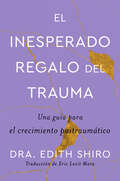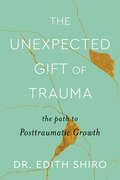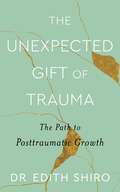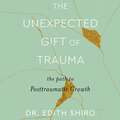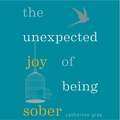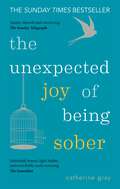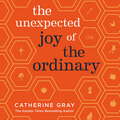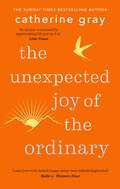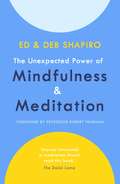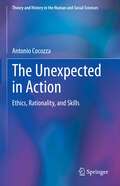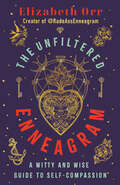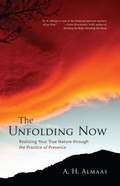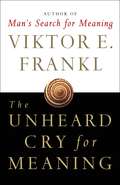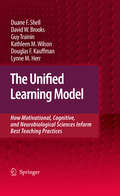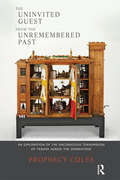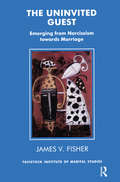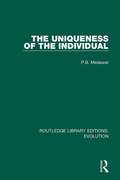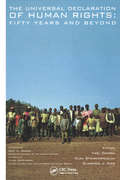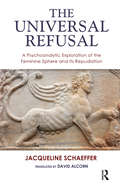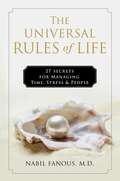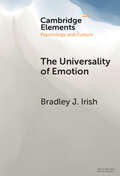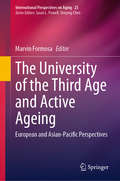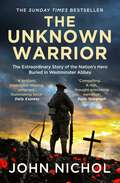- Table View
- List View
The Unexpected Gift of Trauma \ El insospechado regalo del trauma (Sp.): Una guía para el crecimiento postraumático
by Dr. Edith ShiroUn revolucionario libro sobre el trauma, que ofrece a los lectores un esquema de cinco etapas para alcanzar el crecimiento postraumático.El trauma siempre ha sido parte de la experiencia humana, y los eventos traumáticos —tanto físicos como emocionales— pueden trastornar todo nuestro ser y cambiarnos para siempre. Aunque sabemos más que hace diez años acerca de los efectos neurológicos y físicos a largo plazo que deja el trauma, pocos se dan cuenta de que la experiencia del trauma no tiene que condenarlos a una vida de sufrimiento y duelo.En este libro único, la renombrada psicóloga Edtih Shiro comparte un poderos esquema de cinco pasos para el crecimiento postraumático, un proceso terapéutico que ayuda no solo a recuperarse, sino a experimentar crecimiento y renovación después del trauma. Inspirada por sus abuelos, que fueron refugiados y sobrevivientes del Holocausto, la Dra. Shiro ha dedicado su vida a estudiar el trauma y sus secuelas. Desarrolladas a lo largo de más de tres décadas de investigación y práctica, las etapas que propone Shiro —conciencia, despertar, llegar a ser, ser y transformarse— explican cómo el trauma puede ser un catalizador para el cambio positivo y transformador. Fundado en la ciencia y lleno de herramientas prácticas y enseñanzas, El inesperado regalo del trauma revela una nueva y revolucionaria forma de ver el trauma y recuperarse de sus efectos. A groundbreaking book on trauma that offers readers a five-stage framework for achieving posttraumatic growth.Trauma has always been part of the human experience, and traumatic events – both physical and emotional –can shake our very foundation and leave us forever changed. While we know more about the lasting neurological and physical effects of trauma than we did a decade ago, few people realize that experiencing trauma doesn’t have to sentence you to a lifetime of suffering and grief.In this first book of its kind, renowned psychologist Dr. Edith Shiro shares a powerful, five-stage framework for posttraumatic growth, a therapeutic process that helps you not just recover, but experience growth and renewal in wake of trauma. Inspired by her grandparents, who were refugees and Holocaust survivors, Dr. Edith Shiro has dedicated her life to the study of trauma and its aftereffects. Developed over more than three decades of research and practice, Shiro’s stages – Awareness, Awakening, Becoming, Being, and Transforming – outline how trauma can be a catalyst for positive, transformative change.Grounded in science and filled with practical tools and takeaways, The Unexpected Gift of Trauma reveals a groundbreaking new way to think about and heal from trauma.
The Unexpected Gift of Trauma: The Path to Posttraumatic Growth
by Dr. Edith ShiroA groundbreaking approach to healing from trauma and experiencing posttraumatic growth from a leading psychologist, featuring a powerful, five-stage framework to help readers not just recover, but thrive and transform. Trauma has always been part of the human experience, and traumatic events—both physical and emotional—can shake our very foundation and leave us forever changed. While we know more about the lasting neurological and physical effects of trauma than we did a decade ago, few people realize that experiencing trauma doesn’t have to sentence you to a lifetime of suffering and grief.In this first book of its kind, renowned clinical psychologist Dr. Edith Shiro shares a powerful, five-stage framework for posttraumatic growth, a transformational process that helps you not just heal, but achieve growth and expand consciousness in the face of trauma. Inspired by her grandparents, who were refugees and Holocaust survivors, Dr. Shiro has dedicated her life to individuals, families, and communities facing trauma and its aftereffects. Developed over more than twenty-five years of research and practice, Dr. Shiro’s stages—Awareness, Awakening, Becoming, Being, and Transforming— provide a universal language and outline how trauma can be a catalyst for transformative growth.Grounded in science and psychology, and filled with practical tools and takeaways, The Unexpected Gift of Trauma offers a bold a new definition of trauma, touching on individual as well as collective and intergenerational trauma. Dr. Shiro brings the power of posttraumatic growth to the forefront and reveals a groundbreaking new way to think about and heal from traumatic experiences.
The Unexpected Gift of Trauma: The Path to Posttraumatic Growth
by Edith ShiroA groundbreaking approach to healing from trauma and experiencing posttraumatic growth from a leading psychologist, featuring a powerful, five-stage framework to help readers not just recover, but thrive and transform. Trauma has always been part of the human experience, and traumatic events can shake our very foundation and leave us forever changed. While we know more about the lasting neurological and physical effects of trauma than we did a decade ago, few people realize that experiencing trauma doesn't have to sentence you to a lifetime of suffering and grief.In this first book of its kind, renowned clinical psychologist Dr Edith Shiro shares a powerful, five-stage framework for posttraumatic growth, a transformational process that helps you not just heal, but achieve growth and expand consciousness in the face of trauma. Inspired by her grandparents, who were refugees and Holocaust survivors, Dr Shiro has dedicated her life to individuals, families, and communities facing trauma and its aftereffects. Developed over more than twenty-five years of research and practice, Dr Shiro's stages - Awareness, Awakening, Becoming, Being, and Transforming - provide a universal language and outline how trauma can be a catalyst for transformative growth.Grounded in science and psychology, and filled with practical tools and takeaways, THE UNEXPECTED GIFT OF TRAUMA offers a bold a new definition of trauma, touching on individual as well as collective and intergenerational trauma. Dr Shiro brings the power of posttraumatic growth to the forefront and reveals a groundbreaking new way to think about and heal from traumatic experiences.
The Unexpected Gift of Trauma: The Path to Posttraumatic Growth
by Edith ShiroA groundbreaking approach to healing from trauma and experiencing posttraumatic growth from a leading psychologist, featuring a powerful, five-stage framework to help readers not just recover, but thrive and transform. Trauma has always been part of the human experience, and traumatic events can shake our very foundation and leave us forever changed. While we know more about the lasting neurological and physical effects of trauma than we did a decade ago, few people realize that experiencing trauma doesn't have to sentence you to a lifetime of suffering and grief.In this first book of its kind, renowned clinical psychologist Dr Edith Shiro shares a powerful, five-stage framework for posttraumatic growth, a transformational process that helps you not just heal, but achieve growth and expand consciousness in the face of trauma. Inspired by her grandparents, who were refugees and Holocaust survivors, Dr Shiro has dedicated her life to individuals, families, and communities facing trauma and its aftereffects. Developed over more than twenty-five years of research and practice, Dr Shiro's stages - Awareness, Awakening, Becoming, Being, and Transforming - provide a universal language and outline how trauma can be a catalyst for transformative growth.Grounded in science and psychology, and filled with practical tools and takeaways, THE UNEXPECTED GIFT OF TRAUMA offers a bold a new definition of trauma, touching on individual as well as collective and intergenerational trauma. Dr Shiro brings the power of posttraumatic growth to the forefront and reveals a groundbreaking new way to think about and heal from traumatic experiences.
The Unexpected Joy of Being Sober: THE SUNDAY TIMES BESTSELLER
by Catherine GrayTHE SUNDAY TIMES BESTSELLER 'Gray's tale of going sober is uplifting and inspiring' - The Evening Standard 'An icon of the Quit Lit movement' - Condé Nast Traveller 'Fascinating' - Bryony Gordon 'Not remotely preachy' - The Times 'Jaunty, shrewd and convincing' - Sunday Telegraph 'Admirably honest, light, bubbly and remarkably rarely annoying' - Alice O'Keeffe, Guardian 'Truthful, modern and real' - Stylist 'Brave, witty and brilliantly written' - Marie Claire 'The Unexpected Joy of Being Sober came to me at a time when I much needed it... The book became my best friend, and got me through, and took me on a journey.' - Sadie Frost 'Particularly lovely, because it's not a deep and dark dive into someone's terrible addiction. It's a celebration of everything that she has gained from not drinking' - Laura Donnelly Ever sworn off alcohol for a month and found yourself drinking by the 7th? Think there's 'no point' in just one drink? Welcome! There are millions of us. 64% of Brits want to drink less.Catherine Gray was stuck in a hellish whirligig of Drink, Make horrible decisions, Hangover, Repeat. She had her fair share of 'drunk tank' jail cells and topless-in-a-hot-tub misadventures.But this book goes beyond the binges and blackouts to deep-dive into uncharted territory: What happens after you quit drinking? This gripping, heart-breaking and witty book takes us down the rabbit-hole of an alternative reality. A life with zero hangovers, through sober weddings, sex, Christmases and breakups.In The Unexpected Joy of Being Sober, Catherine Gray shines a light on society's drink-pushing and talks to top neuroscientists and psychologists about why we drink, delving into the science behind what it does to our brains and bodies.Much more than a tale from the netherworld of addicted drinking, this book is about the escape, and why a sober life can be more intoxicating than you ever imagined. Whether you're a hopelessly devoted drinker, merely sober-curious, or you've already ditched the drink, you will love this book. 'Haunting, admirable and enlightening' - The Pool 'A riveting, raw, yet humorous memoir with actionable advice. A truly unique blend of storytelling and science that holds a universe of hope.' - Annie Grace, author of This Naked Mind 'Like listening to your best friend teach you to be sober. Lighthearted but serious, it's packed with ideas, tools, tips and, most importantly, reasons for living a sober life. This book is excellent.'- Eric Zimmer, host of podcast The One You Feed 'Gray's fizzy writing succeeds in making this potentially boring-as-hell subject both engaging and highly seductive' - The Bookseller 'Catherine Gray is an exceptional writer. Her exquisitely crafted thoughts on the joys of being sober are not only deeply honest and pragmatic, but she manages to infuse tons of humor. This is a delightful, informative, and compelling read for all those who are sober or seeking sobriety.' - Sasha Tozzi, Huffington Post columnist 'Catherine's writing style and voice captivate me. She has a way of translating her story into an experience I don't want to end. I want to drink every drop she produces.' - Holly Whitaker, founder of Hip Sobriety School and co-presenter of Home podcast 'This book is great. A balanced, informative and entertaining mélange of memoir, sociology and psychology. I identified very strongly with huge sections of it.' - Jon Stewart, guitari
The Unexpected Joy of Being Sober: THE SUNDAY TIMES BESTSELLER (The Unexpected Joy Of #1)
by Catherine GrayGoing sober will make you happier, healthier, wealthier, slimmer and sexier. Despite all of these upsides, it's easier said than done. This inspirational, aspirational and highly relatable narrative champions the benefits of sobriety; combining the author's personal experience, factual reportage, contributions from experts and self-help advice.
The Unexpected Joy of Being Sober: THE SUNDAY TIMES BESTSELLER (The Unexpected Joy Of #1)
by Catherine GrayGoing sober will make you happier, healthier, wealthier, slimmer and sexier. Despite all of these upsides, it's easier said than done. This inspirational, aspirational and highly relatable narrative champions the benefits of sobriety; combining the author's personal experience, factual reportage, contributions from experts and self-help advice.
The Unexpected Joy of the Ordinary
by Catherine Gray**From the Sunday Times Bestselling Author**We're told that happiness is in the extraordinary. It's on a Caribbean sun lounger, in the driving seat of a luxury car, inside an expensive golden locket, watching sunrise from Machu Picchu. We strive, reach, push, shoot for more. 'Enough' is a moving target we never quite reach.When we do brush our fingertips against the extraordinary a deeply inconvenient psychological phenomenon called the 'hedonic treadmill' means that, after a surge of joy, our happiness level returns to the baseline it was at before the 'extra' event.So, what's the answer? The Unexpected Joy of the Ordinary theorises that the solution is rediscovering the joy in the ordinary that we so often now forget to feel. Because we now expect the pleasure of a croissant, a hot shower, a yoga class, someone delivering our shopping to our door, we no longer feel its buzz. The joy of it whips through us like a bullet train, without pause.Catherine Gray was a grandmaster in the art of eye-rolling the ordinary, and skilled in everlasting reaching. Until the black dog of depression forced her to re-think everything.Along the way, she discovered some surprising realities about the extraordinaries among us: that influencers risk higher rates of anxiety and depression, high-rollers are less happy, and huge frothy weddings increase the likelihood of divorce.Learning how to be exalted by the everyday is the most important lesson we can possibly learn. In Catherine Gray's hilarious, insightful, soulful (and very ordinary) next book, you may learn to do just that.PRAISE FOR CATHERINE GRAY'S WRITING:"Fascinating" Bryony Gordon."Not remotely preachy" The Times"Jaunty, shrewd and convincing" The Telegraph "Admirably honest, light, bubbly and remarkably rarely annoying" The Guardian(p) 2019 Octopus Publishing Group
The Unexpected Joy of the Ordinary (The Unexpected Joy Of #4)
by Catherine Gray**From the Sunday Times Bestselling Author**Life-affirming - THE TELEGRAPHWonderful - INDEPENDENTShe made it her mission to learn how to be default happy rather than default disgruntled - RADIO 4 - WOMAN'S HOURTake a leaf out of Gray's book and be kinder to yourself by appreciating life just as it is - IRISH TIMESThis book came to me in an hour of need - during lockdown when I had to focus on the positive, appreciate simple things, not lose my shit, and value each day. It was a pure joy for me and held my hand - SADIE FROSTInteresting and joyful. Lights a path that could help us to build resilience against society's urging to compare life milestones with peers - LANCET PSYCHIATRY Underwhelmed by your ordinary existence? Disillusioned with your middlin' wage, average body, 'bijou' living situation and imperfect loved ones? Welcome to the club. There are billions of us. The 'default disenchanted'. But, it's not us being brats. Two deeply inconvenient psychological phenomenons conspire against our satisfaction. We have negatively-biased brains, which zoom like doom-drones in on what's wrong with our day, rather than what's right. (Back in the mists of time, this negative bias saved our skins, but now it just makes us anxious). Also, something called the 'hedonic treadmill' means we eternally quest for better, faster, more, like someone stuck on a dystopian, never-ending treadmill. Thankfully, there are scientifically-proven ways in which we can train our brains to be more positive-seeking. And to take a rest from this tireless pursuit. Whew.Catherine Gray knits together illuminating science and hilarious storytelling, unveiling captivating research showing that big bucks don't mean big happiness, extraordinary experiences have a 'comedown' and budget weddings predict a lower chance of divorce. She reminds us what an average body actually is, reveals that exercising for weight loss means we do less exercise, and explores the modern tendency to not just try to keep up with the Murphys, but keep up with the Mega-Murphies (see: the social media elite).Come on in to this soulful and life-affirming read, to discover why an ordinary life may well be the most satisfying one of all.
The Unexpected Joy of the Ordinary (The Unexpected Joy Of #4)
by Catherine Gray**From the Sunday Times Bestselling Author**Life-affirming - THE TELEGRAPHWonderful - INDEPENDENTShe made it her mission to learn how to be default happy rather than default disgruntled - RADIO 4 - WOMAN'S HOURTake a leaf out of Gray's book and be kinder to yourself by appreciating life just as it is - IRISH TIMESThis book came to me in an hour of need - during lockdown when I had to focus on the positive, appreciate simple things, not lose my shit, and value each day. It was a pure joy for me and held my hand - SADIE FROSTInteresting and joyful. Lights a path that could help us to build resilience against society's urging to compare life milestones with peers - LANCET PSYCHIATRY Underwhelmed by your ordinary existence? Disillusioned with your middlin' wage, average body, 'bijou' living situation and imperfect loved ones? Welcome to the club. There are billions of us. The 'default disenchanted'. But, it's not us being brats. Two deeply inconvenient psychological phenomenons conspire against our satisfaction. We have negatively-biased brains, which zoom like doom-drones in on what's wrong with our day, rather than what's right. (Back in the mists of time, this negative bias saved our skins, but now it just makes us anxious). Also, something called the 'hedonic treadmill' means we eternally quest for better, faster, more, like someone stuck on a dystopian, never-ending treadmill. Thankfully, there are scientifically-proven ways in which we can train our brains to be more positive-seeking. And to take a rest from this tireless pursuit. Whew.Catherine Gray knits together illuminating science and hilarious storytelling, unveiling captivating research showing that big bucks don't mean big happiness, extraordinary experiences have a 'comedown' and budget weddings predict a lower chance of divorce. She reminds us what an average body actually is, reveals that exercising for weight loss means we do less exercise, and explores the modern tendency to not just try to keep up with the Murphys, but keep up with the Mega-Murphies (see: the social media elite).Come on in to this soulful and life-affirming read, to discover why an ordinary life may well be the most satisfying one of all.
The Unexpected Power of Mindfulness and Meditation
by Deb Shapiro Ed Shapiro'Anyone interested in meditation should read this book.' The Dalai Lama'Ed and Deb remind us all just how important it is to look after the health and happiness of the mind. With warmth and humor they show us how to integrate the timeless qualities of awareness and compassion into everyday life.' Andy Puddicombe, founder, HEADSPACEThis book is essential reading for anyone - both newcomers to mindfulness and meditation as well as long-time devotees - wishing to make positive changes in their lives. It teaches you how to reach your quiet inner place where meditation and mindfulness can help resolve issues such as anger and fear, relationship breakdown, forgiveness, parenthood, and a lack of self-esteem. Read wisdom from the Dalai Lama, Jon Kabat-Zinn and Marianne Williamson who discuss their methods of maintaining good mental health and happiness. People everywhere now realise the profound benefits of mindfulness and meditation to reduce deep-rooted stress, calm the mind, become kinder, and find true happiness.
The Unexpected in Action: Ethics, Rationality, and Skills (Theory and History in the Human and Social Sciences)
by Antonio CocozzaThe book is a true knowledge-enhancing project, dealing with the forms of rationality at work in social life, which are so many, varied and complex. Published already in Spanish and Italian, it analyses the role played by rationality through the lens of social theories in order to propose a problematic interpretation of human action. Since there is nothing more practical than a good theory when seeking to understand our society, the book reflects on the theoretical approaches that provide useful categories by means of which to understand and interpret individual, organizational, and institutional action. It proposes an analysis of a wide variety of classics by eminent European and Anglo-American thinkers, such as Dahrendorf, Mannheim, Marx, Popper, Weber, Habermas, Luhmann, Machiavelli, Pareto, Ardigò, Cesareo, Parsons, Schütz, Alexander, Bauman, Beck, Sennett, Antiseri, Boudon, Sen, Simon, to shed light on the relationship between rationality, difficulties in thinking and extra-rationality. Finally, the reasons for unexpected action are investigated as well as the strategic role played by ethics, rationality and skills in postmodern societies on the basis of the contributions of Nussbaum and Piketty.
The Unfiltered Enneagram: A Witty and Wise Guide to Self-Compassion
by Elizabeth OrrFrom Instagram&’s snarkiest Enneagram expert comes a hilarious and insightful book that shows how embracing our shadow side is our best path toward greater self-awareness and compassion.Most Enneagram books focus on stroking ego rather than challenging it. Elizabeth Orr&’s The Unfiltered Enneagram offers practical strategies for liberating yourself from your own garbage. It&’s a humorous, no-frills reckoning with our shadow side—the ways we cope with stress or fear—that unlocks the life-changing wisdom of this popular personality typology system. Readers will discover that courageously and comically acknowledging the worst attributes of their Enneagram Type can bring out the best in themselves.Filled with laugh-out-loud descriptions, sobering truths, and inspiring prompts, each chapter is an under-the-rug look at the nine Enneagram Personality Types:• Type One—R Is for Reformer (and Resentment)• Type Two—Self-Sacrifice with Some Serious Strings Attached• Type Three—Hall of Mirrors in a House of Cards• Type Four—Feelin&’ Misunderstood (and I&’m Going to Make It Your Problem)• Type Five—When Intellectual Maximalism Meets Emotional Minimalism• Type Six—Who Needs Trust When I&’ve Got Projection?• Type Seven—The Paradoxical Paralysis of Making Too Many Awesome Plans• Type Eight—Large, in Charge, and Just This Side of Belligerent• Type Nine—Comfortably Numb (and Impressively Stubborn)Insightful for long-time Enneagram enthusiasts, pragmatic for newer fans, and hilarious and accessible for everyone, The Unfiltered Enneagram shines a generous light on the good, the bad, and the ugly sides of us all—inviting us to see that the only way to find self-compassion is to embrace wholeness.
The Unfolding Now: Realizing Your True Nature through the Practice of Presence
by A. H. AlmaasThe keys to self-knowledge and deep contentment are right here before us in this very moment--if we can simply learn to live with open awareness. In The Unfolding Now, A. H. Almaas presents a marvelously effective practice for developing the transformative quality of presence. Through a particular method of self-observation and contemplative exploration that he calls inquiry, we learn to live in the relaxed condition of simply "being ourselves," without interference from feelings of inadequacy, drivenness toward goals, struggling to figure things out, and rejecting experiences we don't want. Almaas explores the many obstacles that keep us from being present--including defensiveness, ignorance, desire, aggression, and self-hatred--and shows us how to welcome with curiosity and compassion whatever we are experiencing.
The Unheard Cry for Meaning: Psychotherapy and Humanism (Playaway Adult Nonfiction Ser.)
by Viktor E. FranklIn our age of depersonalization, Frankl teaches the value of living to the fullest.Upon his death in 1997, Viktor E. Frankl was lauded as one of the most influential thinkers of our time. The Unheard Cry for Meaning marked his return to the humanism that made Man's Search for Meaning a bestseller around the world. In these selected essays, written between 1947 and 1977, Dr. Frankl illustrates the vital importance of the human dimension in psychotherapy. Using a wide range of subjects—including sex, morality, modern literature, competitive athletics, and philosophy—he raises a lone voice against the pseudo-humanism that has invaded popular psychology and psychoanalysis. By exploring mankind's remarkable qualities, he brilliantly celebrates each individual's unique potential, while preserving the invaluable traditions of both Freudian analysis and behaviorism.
The Unified Learning Model
by Kathleen M. Wilson Guy Trainin David W. Brooks Duane F. Shell Douglas F. Kauffman Lynne M. HerrThis cutting-edge synthesis of ideas and concepts from the cognitive, motivation, and neurobiological sciences sets out a unique theory of learning that should be of interest to everyone from education practitioners to neuroscientists. The authors base their Unified Learning Model, or ULM, on three core principles. Firstly, that learning requires working memory allocation (attention). Second, that working memory's capacity for allocation is affected by prior knowledge. And finally, that working memory allocation is directed by motivation. These three principles guide a complete model of learning that synthesizes what is known from research in brain function, cognition, and motivation. This, then, is a book about how humans learn. Its focus is on classroom learning although the principles are, as the name of the book suggests, universal. The text's scope covers learning from pre-school to post-graduate, as well as training in business, industrial and the military. It addresses all learning described by the word "thought", as well as anything we might try to teach, or instruct in formal educational settings. The book presents a model of learning that the authors offer as scientists rather than educators. They assert that more than enough is known to sustain a "scientific" model of learning. Rather than being a mere review of the literature, this work is a synthesis. Many scholars and teachers will have heard much if not most or even all of the information used to develop the model. What they will not have come across is a model - designed to be both accessible and usable - that puts together the information in just this way.
The Uninvited Guest from the Unremembered Past: An Exploration of the Unconscious Transmission of Trauma Across the Generations
by Prophecy ColesThis book describes different instances of trauma that may have occurred several generations ago. It explores the work of several psychoanalysts who have written on the negative effect that unknown or unremembered grandparents can have upon the life of their grandchildren.
The Uninvited Guest: Emerging from Narcissism towards Marriage
by James V. FisherThis book brings together a deep thoughtfulness about the insights of psychoanalysis and its application to work with troubled couples with an original and closely argued reading of some classic plays about marriage. It will be of use to readers interested in psychoanalysis and literature.
The Uniqueness of the Individual (Routledge Library Editions: Evolution #8)
by P.B. MedawarOriginally published in 1957, The Uniqueness of the Individual is a collection of 9 essays published from the ten years preceding publication. The essays deal with some of the central problems of biology. These are among the questions put and answered from the standpoint of modern experimental biology. What is ageing and how is it measured? What theories have been held to account for it, and with what success? Did ageing evolve, and if so how? Is Lamarckism and adequate explanation of evolutionary process? Does evolution sometimes go wrong? Do human beings evolve in a way peculiar to themselves? Other essays touch upon the problems of scientific method and of growth and transformation. This book will be of interest to natural historians, evolutionists and anthropologists.
The Universal Declaration of Human Rights: Fifty Years and Beyond
by Yael Danieli Elsa Stamatopoulou Clarence DiasContaining contributions by specialists from the intergovernmental and non-governmental worlds and voices of victim/survivors, the book critically reviews the international and regional human rights systems established over the past 50 years in terms of their effectiveness for the victims of human rights violations, and provides future directions for the promotion and protection of human rights.
The Universal Refusal: A Psychoanalytic Exploration of the Feminine Sphere and its Repudiation
by Jacqueline SchaefferFreud spoke of the “repudiation of femininity” as being an “underlying bedrock”, part of the “enigma” of sexuality. The enigma is not so much the refusal of the feminine dimension as such; it has more to do with rejecting its erotic and genital aspects, as well as its creation through sexual ecstatic pleasure. Equality between the sexes is a legitimate demand in the political, social, and economic spheres, but forming a masculine–feminine relationship as a couple is a creation of the mind, exalting the acknowledgement of the otherness which is part of the difference between the sexes. There is a conflict in woman – and the feminine dimension itself is rooted in it – between a sexuality that demands “defeat” and an ego that abhors this. It is the man’s masculine dimension – the antagonist of the phallic one – which creates the feminine dimension in women, by tearing away their defences and generating sexual ecstasy. The quality of the sexual, emotional, and social relationship that is set up between a man and a woman bears witness to the “work of civilization” (Kulturarbeit).
The Universal Rules of Life: 27 Secrets for Managing Time, Stress, and People
by Nabil FanousDeveloped by Dr Nabil Fanous—a surgeon, university professor and sought-after speaker—The Universal Rules of Life offers valuable insights into effective time management, personal fulfillment, and the path to professional success.Discover the easy and smart answers to the following questions that have intrigued you for years: What&’s the one sentence that will get you what you want 50% of the time? What are the 3 time management secrets of doing what you don&’t have time to do? What are the 4 best-kept and indispensable secrets to achieving happiness? How you can create a commanding presence, before you even utter a word? How you can mesmerize anyone you talk to? What are the 9 crucial steps for prevention and early detection of cancer, heart disease, diabetes, and Alzheimer&’s disease? What should you do when you feel torn between several options, and can&’t make a decision? How you can break the &“I will&” habit, and do now what you've always wanted to do but never did? How can you get people to appreciate you, to relish hearing from you, and to compete to get together with you? How you can give criticism and disagree, yet remain liked and respected? How can you solve any worrisome problem in less than 5 minutes? How can you create smart effortless habits that simplify your life? What are the 2 questions you must ask yourself when faced with a life crisis or a serious health problem? What&’s the secret recipe for managing the difficult people in your life? What are the 2 questions that will instantly make you feel better when you&’re disappointed or depressed?
The Universality of Emotion: Perspectives from the Sciences and Humanities (Elements in Psychology and Culture)
by Bradley J. IrishNot supplied by the author. This Element surveys how a number of major disciplines − psychology, neuroscience, sociology, anthropology, philosophy, history, linguistics, and literary/cultural studies − have addressed the long-standing research question of whether human emotions should be thought of as meaningfully 'universal.' The Element presents both the universalist and anti-universalist positions, and concludes by considering attempts to move beyond this increasingly unhelpful binary.
The University of the Third Age and Active Ageing: European and Asian-Pacific Perspectives (International Perspectives on Aging #23)
by Marvin FormosaThis comparative resource charts the interface between the University of the Third Age (U3A) movement and active ageing, and in doing so, offers a comprehensive and thorough understanding of what U3A means in different geographical and sociocultural contexts. After first providing introductory chapters to introduce the U3A movement and active ageing in global perspective and tracing the origins of U3As in France, the book sets off charting the international development of U3As in both European and Asian-Pacific contexts. Deliberately, the book moves away from the dominant Anglo-centric US- and UK-rooted analyses of U3As to account for contexts of different political ideology, sociocultural values, geography, and degrees of urbanisation and industrialisation. Lastly, it thematises foreseeable issues, concerns, and predicaments that the global U3A movement faces while meeting the challenges and seizing the opportunities presented by active ageing.The chapters’ comparative perspectives encompass: Origins and development: The Francophone model of U3As The development and characteristics of U3As in European and Asian-Pacific geographies From social welfare to educational gerontology: U3As in China, Russia, Taiwan, Malaysia and South Korea U3As in Italy, Spain and Sweden: A dynamic, flexible, and accessible learning model Late-life learning for social inclusion: U3As in Poland, Iceland, United Kingdom, and Malta The U3A movement in Australia: From statewide networking to community engagement Cross-cultural perspectives on U3As: The case of Thailand The University of the Third Age and Active Ageing boasts welcome contributions to the scholarship on the different histories, structures, and challenges posed by national U3As. Readers from a variety of backgrounds and research interests including gerontology, geriatrics, active ageing, older adult learning, comparative education and educational technology will find this a necessary and valuable resource in better understanding a globalised U3A world."The University of the Third Age and Active Ageing: European and Asian-Pacific Perspectives contributes to the deep well of histories, experiences, structures, accomplishments and problems of national U3As. It emerges as a tapestry of extraordinary research that offers to guide the U3A movement as it soon enters its fiftieth year of existence." - Prof. Stephen Katz. Trent University
The Unknown Warrior: A Personal Journey of Discovery and Remembrance
by John Nichol&‘Compelling… [Nichol has a] terrific eye for detail; an ability to blend tear-jerking letters, quotation and personal anecdotes into a rich, thought-provoking narrative&’Daily Telegraph Over one million British Empire soldiers were killed during the First World War. More than a century later, over half a million still have no known grave. The scale of the fighting, the catastrophic destruction, the relentless military engagement and glutinous mud meant that many of the dead were never identified, of often, never recovered. Names were left without bodies, and bodies, or fragments of bodies, without names. To help staunch the tide of national grief in the aftermath of the conflict, an idea was born for a single 'Unknown Warrior' representing all the missing, to be brought from the battlefields and buried in Westminster Abbey alongside the nation's kings and queens. Using diaries, archives and interviews with the descendants of that generation and modern-day experts, Sunday Times bestselling author and former RAF Tornado navigator John Nichol draws on his own experience of combat and loss to shine light on this 100-year-old story. And in speaking to those who have lost loved ones in more modern conflicts, he examines our continuing need for a tangible resting place at which to truly grieve the fallen. His search for answers becomes a moving and personal journey, exploring the true meaning of camaraderie, service, sacrifice and remembrance.
